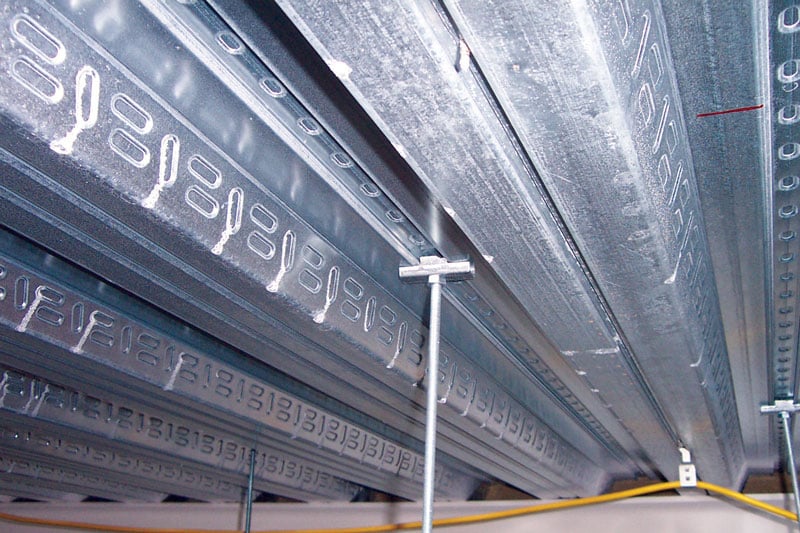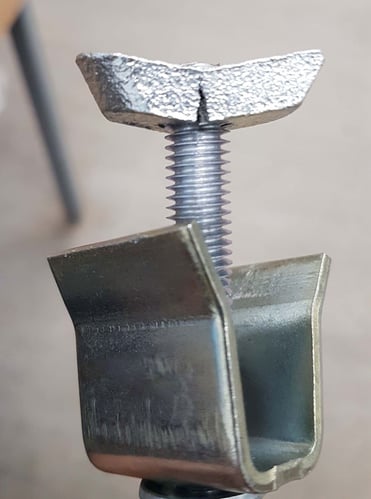Decking fixings play an indispensable role in construction, offering a reliable method to suspend building services from various types of surfaces, including composite deck floors, pre-cast hollow concrete ceiling slabs, and steel sheeting. Despite their importance, the installation and selection of decking fixings are topics often overlooked in the construction industry, leading to potential safety hazards and compliance issues. In this comprehensive guide, we will delve into the critical aspects of safety and compliance related to the installation of decking fixings.
- #1 Incorrect Selection
- #2 Failure to Identify Decking Types
- #3 Overtightening
- #4 Not Checking for Tolerance
- #5 Drilling into Concrete
- Conclusion

#1 Incorrect Selection
Selecting the right type of decking fixing is paramount for ensuring the safety and stability of your construction project. While there are several options available in the market, understanding the compatibility of these fixings with different types of decking materials is essential.
One of the most fundamental and yet frequently committed mistakes when installing decking fixings is neglecting proper selection. Choosing the wrong type of fixing can lead to a subpar installation, increasing the risk of instability and safety hazards.
Here are the two factors that should be considered prior to selecting a decking fixing:
Types of Decking Fixings:
Decking fixings come in various forms, each designed to serve specific purposes and accommodate different installation scenarios. Understanding these types is fundamental to making the correct choice for your project.
- Wedge Nuts: Wedge nuts are commonly used for threaded rod suspended fixings. They secure threaded rods used to suspend building services and are designed to fit into the V slots of composite floor deckings. Variations include standard wedge nuts, mini wedge nuts, and mini-mini wedge nuts, each suited for specific applications.
- Wedge Hangers: Wedge hangers consist of a wedge that secures into the decking and a locking plate to hold the fixing in place. They are also used for threaded rod applications and offer stability and ease of installation.
- Toggle Clamps: Toggle clamps, like Lindapter TC, are used for service suspensions from hollow concrete floor slabs and steel decks. They are known for their heavy-duty capabilities and the ability to withstand high loads.
- Toggle Studs (Type TD): Toggle studs are toggle fixings with threaded rods used for service suspensions, typically from steel decks and hollow concrete floor slabs. They are a robust option for heavy-duty applications.
- Erico GTD Clips: These spring steel clips perform similarly to wedge nuts but offer greater flexibility in accommodating variations in decking slots. They can be particularly useful in installations where decking slots have become compressed.
- Trapezoidal Decking Hanger: Designed specifically for trapezoidal metal sheet decks, these fixings require the use of an M8 x 100 retaining bolt.

#2 Failure to Identify Decking Types
Properly identifying the type of decking you are working with is essential for the correct selection and installation of fixings. Different types of decking have unique profiles and patterns that require specific fixings for optimal performance. Without proper identification, you risk using incompatible fixings that may not provide the necessary support or could damage the decking material.
Identifying the type of decking can be a challenging task, especially when you are not aware of the manufacturer, or the profile appears unfamiliar. Often, valuable time can be wasted attempting to correctly identify the decking type. Even when you do know the manufacturer, the quality of available information may vary significantly. Technical specifications provided by manufacturers typically focus on the installation of the decking itself rather than providing subcontractors with guidance on which fixings to use.

Unless the main contractor has explicitly specified the decking type, and this information has been communicated to the sub-contractors, they may find themselves facing a steel decking profile devoid of any apparent branding to help distinguish its type. This lack of identification makes it challenging to determine which fixings are compatible without seeking further advice. To successfully identify a particular type of decking, you should consider three crucial factors:
Profile Pattern
Examine the pattern stamped on the inside of the decking profile, typically consisting of a recurring combination of symbols. Manufacturers have meticulously designed these patterns to aid in the identification of their decking products.
Fixing Recess Dimensions
Most decking types feature a fixing recess with specific dimensions tailored to accommodate the corresponding fixing, ensuring a secure attachment. Measure both the width at the bottom of the fixing recess and, if feasible, its height.
Profile Shape
Inspect the profile as a cross-section to discern its shape. Is it wide or narrow? Shallow or deep?
#3 Overtightening
Decking fixings, particularly wedge nuts and the wedge component of wedge hangers, are crafted from cast iron rather than steel. This involves melting the material, pouring it into moulds, and allowing it to solidify. A common but misguided assumption prevailing in the industry is that the tighter you secure a decking fixing, the more secure it becomes. This misconception isn't unique to decking fixings; it's prevalent in various types of fasteners, including throughbolts, where the prevailing notion is to tighten until you can't turn anymore.

However, this approach is fundamentally flawed. Decking fixings rely on a wedge-shaped profile to anchor themselves, and the nut portion serves to immobilize the assembly. Consequently, there's no need to overtighten them. In fact, tightening beyond the manufacturer's recommended torque can lead to detrimental consequences. Cast iron, although durable and malleable when utilized correctly, can become susceptible to cracking when subjected to excessive torque.
The key here is proper installation. When decking fixings are installed correctly, there should be no concerns about their durability and functionality. The inherent strength of cast iron, combined with its suitability for the intended purpose, ensures that the fixings will perform as intended.
Ultimately, it's crucial to recognize that overtightening is not the path to enhanced security but rather a potential avenue to compromised product integrity and project failures. Therefore, always adhere to the manufacturer's recommended tightening torque, ensuring that your decking fixings are installed with the precision and care necessary for a safe and reliable construction project.
In the realm of composite decks, metal decking is often laid down before pouring concrete on top. While this construction method is effective, it can introduce challenges related to the tolerance and integrity of the decking profile.
#4 Not Checking for Tolerance
The weight placed on a composite deck can cause the metal deck to flex. This flexing can lead to the profile of the wedge expanding, resulting in an adjusted entrance width. This change in the profile can significantly impact the load capacity of the fixing, making it unfit for secure installation.
When faced with a compromised decking profile, some individuals may attempt to tighten the fixing even more to compensate for the expanded entrance width. However, this course of action often exacerbates the problem rather than solving it.
To address this challenge, it is crucial to visually inspect the entrance to the wedge profile before installation. Ensuring that the weight of the concrete has not impacted the integrity of the profile is essential. If any compromise is detected, it is advisable to consult with fixings and supports specialists to determine the most efficient and cost-effective solution.
One potential approach to overcoming this issue is to find an unaffected channel within the decking and create a suspension that spans both sides of the compromised area. This method can help distribute the load more evenly and maintain the structural integrity of the installation.

The failure shown in this image is explicitly a result of incorrect installation and in no way is it a product failure as is often assumed.
#5 Drilling into Concrete
In some situations, individuals may consider bypassing the wedge technology of metal decking and opt to drill through the metal deck to access the concrete below. This approach involves cutting out a section from the metal underneath to expose part of the concrete, allowing for the use of concrete fixings.
While this method has traditionally been regarded as an acceptable solution, it comes with significant drawbacks that can compromise safety and compliance. As soon as you penetrate the steel profile of the decking, you effectively dissolve its fire integrity. This is a critical concern because the combination of concrete and metal in a composite deck is designed to provide fire prevention and prevent the spread of fire between floors.
By penetrating the steel profile, you negate the advantages of fire resistance that composite decking offers. From an evidence-based perspective, it becomes impossible to claim that the fire integrity of the decking has been maintained.
Instead of drilling into concrete, it is essential to adhere to the intended use of decking fixings. These fixings are specifically designed to be compatible with the decking material, ensuring that the fire integrity and overall safety of the structure are preserved.
Conclusion
In conclusion, the installation of decking fixings should never compromise safety or compliance. By prioritising proper selection, identifying decking types, adhering to recommended torque settings, addressing tolerance issues, and avoiding detrimental shortcuts, you can ensure the integrity and longevity of your construction projects.

